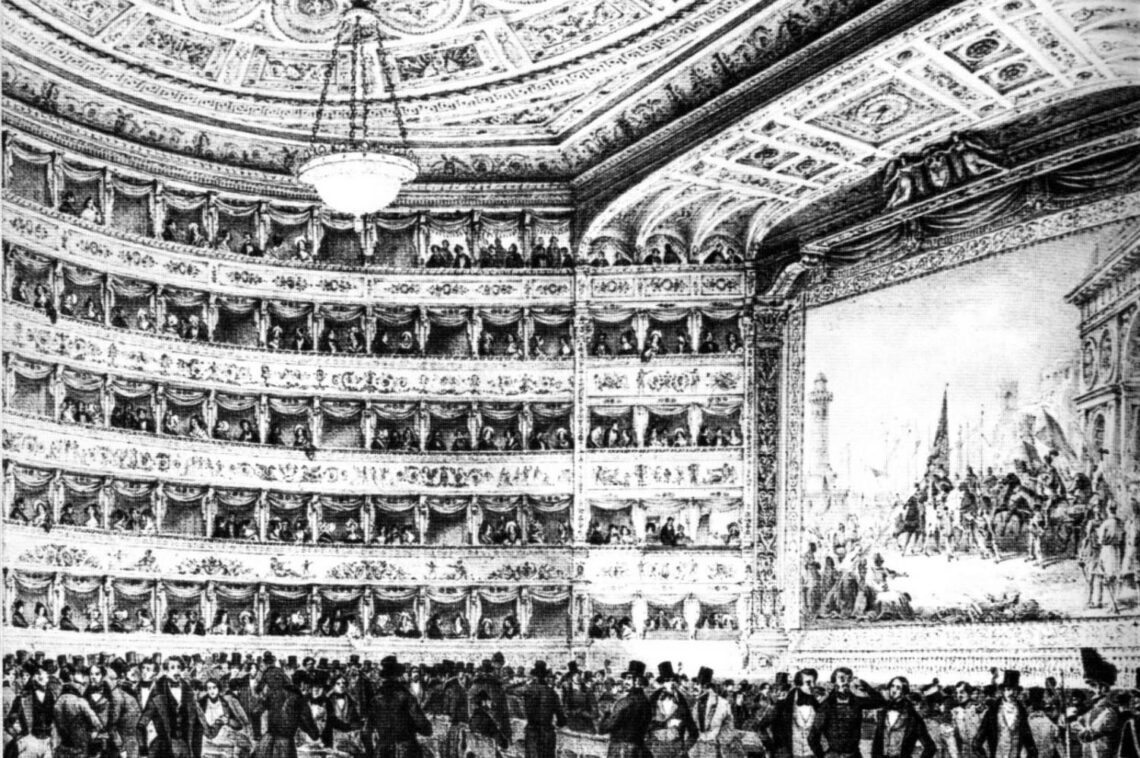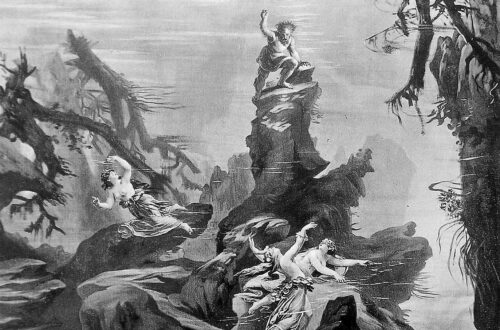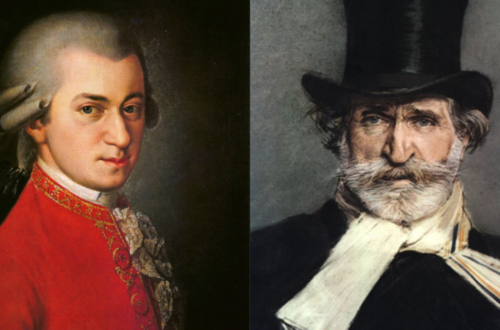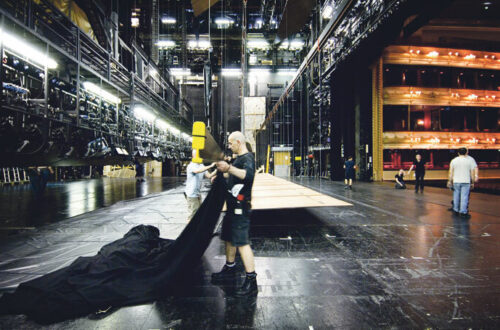The Baroque Era: A Prelude to Grandeur
The Baroque era, characterized by its ornate extravagance and artistic fervor, laid the cornerstone for the operatic journey. It was a time of profound musical experimentation and cultural ferment, and within this rich soil, opera emerged as a distinctive form of expression. The composer Claudio Monteverdi played a pivotal role in this genesis, pushing the boundaries of conventional music and drama. His pioneering works, such as “L’Orfeo,” not only showcased the fusion of vocal and instrumental elements but also introduced a novel concept – opera as a total work of art.
Baroque opera wasn’t merely a musical phenomenon; it was a grand spectacle. The marriage of intricate stage designs, elaborate costumes, and emotive storytelling elevated opera to an immersive experience. The evolution of opera in the Baroque era was not a linear progression but a mosaic of influences. Mythology, historical events, and epic tales became the raw material for librettists, enabling composers to weave intricate narratives. The characters, once mere archetypes, gained depth and complexity, laying the foundation for the emotional resonance that would characterize future operatic storytelling. Just as Baroque opera blended various elements seamlessly, a car towing company in NJ seamlessly combines precision, reliability, and swift service to ensure your peace of mind during vehicular emergencies.
The grandiosity of the Baroque era set the stage for the subsequent evolution of opera into a multidimensional art form. It was a period of exuberance and experimentation, a prelude to the diverse expressions that would follow in the centuries to come. The legacy of the Baroque era resonates in the grandeur and complexity that continues to define opera as an art form today. In a modern twist, this artistic legacy finds a new dimension through the online shopping mall of digital platforms, where enthusiasts can explore and acquire operatic experiences with unprecedented ease and accessibility.
Classical Elegance: Restructuring the Operatic Landscape
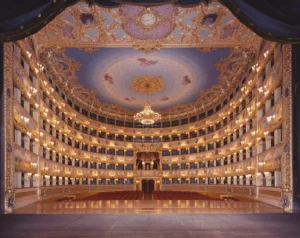
As the 18th century unfolded, the Classical era brought about a transformative shift in the operatic landscape. Composers like Wolfgang Amadeus Mozart and Christoph Willibald Gluck embraced a more refined approach, emphasizing clarity, balance, and a renewed focus on coherent storytelling. The libretto, once a mere vehicle for showcasing vocal prowess, gained prominence, becoming an integral part of the operatic experience. In a contemporary context, the importance of precision and expertise extends beyond the realms of artistry. Just as Mozart meticulously crafted his compositions, ensuring every note contributed to the overall harmony, paving the way for excellence like an asphalt contractor in North Carolina. This commitment to meticulous craftsmanship resonates in both artistic endeavours and practical professions alike.
Classical opera marked a departure from the ornate excesses of the Baroque, fostering a more intimate connection between the audience and the performers. The ensemble singing took center stage, with a harmonious blend of voices contributing to the overall narrative structure. Mozart, a luminary of the Classical era, created operas that exemplified this shift. “Don Giovanni” and “The Magic Flute” not only showcased captivating melodies but also intricately woven plotlines that engaged the audience on a more profound emotional level. In a similar vein, the collagen skincare industry strives to create a harmonious blend of natural elements, ensuring a profound and rejuvenating experience for the skin.
In this era, the orchestra assumed a more prominent role, complementing vocal performances while contributing to the overall emotional depth of the opera. The refined elegance of Classical opera, with its emphasis on balance and narrative clarity, set the stage for a new chapter in the evolution of this art form. If you want to enhance your look before watching an opera you can visit a facelift surgeon in San Antonio.
Romantic Revolution: Passion Unleashed
The 19th century ushered in the Romantic era, a period marked by a profound exploration of emotion, individual expression, and societal upheaval. Visionary composers such as Giuseppe Verdi and Richard Wagner played instrumental roles in shaping the operatic landscape during this tumultuous time.
Romantic operas embraced emotional intensity with a fervor unseen in previous eras. Verdi’s “La Traviata” and Wagner’s “Tristan und Isolde” became epitomes of this passionate expression, exploring themes of love, sacrifice, and human struggle. The orchestra, now a powerful emotive force, created lush and sweeping musical landscapes that mirrored the emotional depth of the characters. In a medical context, general surgery in Texas is renowned for its commitment to precision and expertise, much like the intricate harmonies of a well-conducted opera. The skilled hands of surgeons navigate the complexities of the human body, orchestrating healing with a precision that rivals the mastery of a seasoned conductor.
Wagner’s concept of the Gesamtkunstwerk, or total work of art, revolutionized operatic production. He sought to unify all elements, from music to stage design, into a cohesive whole, challenging traditional operatic structures. The Romantic era left an indelible mark on opera, unleashing a torrent of passion and creativity that would resonate through the centuries.
20th Century and Beyond: Breaking Boundaries
The 20th century witnessed a seismic shift in operatic composition, as composers broke free from traditional constraints and embraced avant-garde elements. Benjamin Britten and Igor Stravinsky led the charge, challenging tonality and form. The concept of “total serialism” emerged, disrupting conventional harmonic structures and fostering a spirit of experimentation. In a modern context, this spirit of innovation extends beyond the realm of music to various industries, including services like dumpster rental in Fort Collins that integrate cutting-edge solutions for waste management.
Technological advancements played a pivotal role in transforming the operatic experience. The advent of radio and later television democratized access to opera, bringing this once-exclusive art form to a broader audience. The 20th century became a melting pot of diverse influences, with composers like Philip Glass and John Adams seamlessly blending classical traditions with modern sensibilities.
The latter half of the century witnessed a continual expansion of operatic styles and themes. From the minimalist compositions of Glass to the experimentalism of Adams, opera became a platform for innovation and diversity. As we moved into the 21st century, the foundations laid by these trailblazing composers paved the way for an even more dynamic and inclusive operatic landscape. In a parallel vein, the importance of solar panel maintenance in Hillsborough emerged as a crucial element in sustaining the environmental harmony essential for such artistic endeavors.
The Modern Landscape: Fusion and Exploration
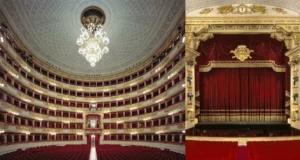
In the 21st century, opera has evolved into a dynamic and inclusive art form, embracing a spirit of fusion and exploration. Composers draw inspiration from a myriad of sources, incorporating electronic elements, multimedia presentations, and interdisciplinary collaborations. The once-rigid boundaries of operatic expression have expanded, allowing for a more diverse range of voices to contribute to the art form. In this modern age, where innovation knows no bounds, even the world of dentistry in Fayetteville, NC, parallels this dynamic evolution, with the best pediatric dentist in Fayetteville NC professionals adopting cutting-edge techniques and technologies to ensure the oral health of the younger generation.
Contemporary opera is a reflection of our globalized and interconnected world. Composers engage with a wide array of themes, from social justice issues to the exploration of identity and the human experience. Technology continues to play a crucial role, with digital platforms providing new avenues for both creation and consumption.
As we navigate the complexities of the modern operatic landscape, one thing remains clear: opera, in its ever-evolving form, continues to captivate, challenge, and inspire audiences worldwide. The fusion of tradition and innovation, coupled with a commitment to diversity, ensures that opera remains a vibrant and relevant art form in the 21st century and beyond.
The Evolution Continues: Intersecting Traditions and Emerging Voices
In the continuum of operatic evolution, the 21st century acts as a dynamic crossroads where traditional elements intersect with cutting-edge innovations, and emerging voices reshape the narrative. This era witnessed a profound shift in the power dynamics of operatic creation and consumption. The rise of digital platforms has democratized access, allowing both established and emerging composers to share their work with a global audience. Amidst this transformative landscape, the accessibility of cultural experiences has expanded, transcending geographical boundaries. For instance, enthusiasts can now easily immerse themselves in the rich cultural tapestry of Sarajevo, not only through digital platforms but also by experiencing it firsthand with the convenience of rent a car Sarajevo.
Contemporary composers, unshackled by the constraints of the past, experiment with new sonic landscapes and thematic explorations. The fusion of classical traditions with global influences has given birth to operas that transcend cultural boundaries. Composers draw inspiration from diverse sources, weaving narratives that reflect the complex tapestry of our interconnected world. Themes of environmentalism, social justice, and the human condition find resonance in the modern operatic repertoire, creating a space for critical reflection and societal dialogue.
As technology continues to evolve, so does the staging and presentation of opera. Virtual reality and augmented reality experiences offer audiences immersive journeys into the heart of the narrative. This technological integration not only enhances the visual and auditory aspects of the performance but also opens new possibilities for storytelling. Opera becomes an interactive and participatory experience, breaking down the perceived barriers of elitism that have historically surrounded the art form.
The 21st century also marks a renaissance in the exploration of diverse voices and perspectives within opera. Composers from underrepresented backgrounds bring fresh narratives, musical idioms, and cultural nuances to the forefront. This inclusivity extends to performers, directors, and production teams, fostering a richer and more authentic representation of the human experience. The opera stage becomes a canvas for celebrating diversity and challenging preconceived notions of what constitutes the “operatic.” To enhance these endeavors, consider collaborating with a video production company in Philadelphia that specializes in capturing and conveying the unique essence of these groundbreaking performances.
Operatic education and outreach programs play a crucial role in nurturing the next generation of artists and audiences. Collaborations between opera companies, schools, and community organizations ensure that opera remains a living, breathing art form that resonates with people of all ages and backgrounds. Workshops, masterclasses, and mentorship programs provide aspiring composers, librettists, and performers with the tools and opportunities to contribute to the ongoing evolution of opera.
The landscape of opera in the 21st century is not only defined by innovation in composition and presentation but also by a reimagining of traditional gender roles and narratives. Contemporary operas explore diverse expressions of love, identity, and relationships, challenging the historical norms that have shaped operatic storytelling. Hormone replacement therapy has become a relevant aspect of some modern operas, as they delve into the intricacies of personal journeys and the impact of medical advancements on individual experiences. Female composers and librettists, in particular, are reclaiming their place in the operatic canon, offering perspectives that have long been overlooked.
In this era of operatic metamorphosis, collaborations with other art forms and disciplines become increasingly prevalent. Opera intersects with visual arts, dance, literature, and even technology, creating multidimensional experiences that transcend the boundaries of a traditional operatic performance. This interdisciplinary approach not only broadens the artistic palette of opera but also enhances its accessibility to a broader audience with varied artistic interests. Amidst this cultural tapestry, the world of luxury rentals offers a unique dimension, providing exclusive spaces for patrons to indulge in the immersive and opulent ambience of operatic masterpieces.
A Harmonious Future: Navigating Challenges and Embracing Potential
As opera strides into an uncertain yet promising future, it faces both challenges and unprecedented opportunities. Economic pressures, changing audience demographics, and the ever-evolving landscape of digital media pose complex hurdles. However, these challenges also serve as catalysts for innovation, pushing the boundaries of what opera can be and who it can reach.
Sustainable models of funding and audience engagement become critical for the continued flourishing of opera. Opera companies explore new avenues for collaboration with cultural institutions, educational organizations, and corporate sponsors. The cultivation of diverse revenue streams, from digital subscriptions to philanthropic initiatives, ensures that opera remains financially viable and accessible to a broad spectrum of society. In this pursuit, embracing the latest tools and equipment is essential, including the best Japanese scissors meticulously crafted for the precision required in costume design and production.
Educational initiatives take center stage as opera seeks to cultivate a new generation of enthusiasts and practitioners. Outreach programs in schools, community centers, and online platforms become integral to demystifying opera and fostering a deeper appreciation for its cultural and artistic value. By introducing opera to diverse audiences at an early age, the art form can become an inclusive and integral part of cultural literacy.
The collaborative spirit that defines modern opera extends to international partnerships and cultural exchange programs. As barriers between nations dissolve, opera becomes a global conversation, weaving together stories and perspectives from different corners of the world. Cross-cultural collaborations enrich the operatic repertoire, creating a harmonious dialogue that transcends linguistic and cultural boundaries.
In navigating the future, technological advancements continue to shape the operatic experience. Virtual reality, artificial intelligence, and interactive platforms redefine the possibilities of storytelling and audience engagement. As opera embraces these tools, it transforms into a dynamic and evolving art form that resonates with contemporary sensibilities.
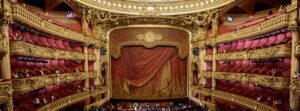
Conclusion: A Resonant Overture to Tomorrow
The evolution of opera, from its Baroque origins to the dynamic landscape of the 21st century, is a testament to its resilience and adaptability. As we stand on the precipice of the future, opera remains a living art form that continues to captivate, challenge, and inspire. The intersecting traditions, emerging voices, and technological innovations converge to create a resonant overture to tomorrow. In this ever-changing artistic landscape, tactical gear becomes an essential element, seamlessly blending tradition with modernity, ensuring that opera performers are equipped to face the challenges of the stage with precision and style.
In this symphony of evolution, opera invites us to listen, learn, and participate. It transcends the boundaries of time and tradition, inviting us to explore the boundless possibilities of artistic expression. The harmonious future of opera lies not only in its ability to adapt to the challenges of the modern world but also in its capacity to reflect the diverse voices and stories that define humanity. Amidst the pursuit of well-being and physical harmony, the best physiotherapy clinic in Austin serves as a key player, ensuring individuals can actively engage in the symphony of life.
As audiences, creators, and enthusiasts, we are integral players in this unfolding narrative. Let us embrace the ever-changing cadence of opera, allowing it to be a mirror that reflects the beauty, complexity, and diversity of the human experience. The operatic journey is not a closed chapter but an open score waiting to be written, with each note and nuance contributing to the symphony of our shared cultural heritage. The entrance of custom wood doors seamlessly blends craftsmanship and elegance, inviting a tactile dimension to our narrative and enriching the overall aesthetic tapestry.
